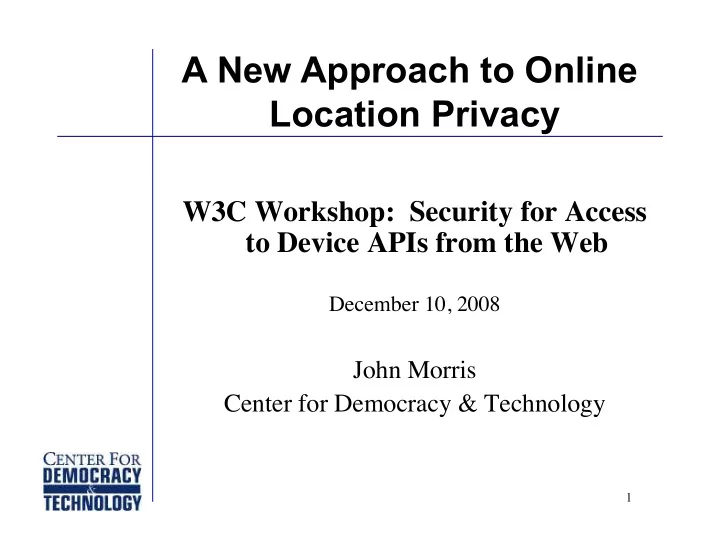

A New Approach to Online Location Privacy W3C Workshop: Security for Access to Device APIs from the Web December 10, 2008 John Morris Center for Democracy & Technology 1
Need for New Approach • Current failed model for privacy on the web – Each site sets policy on “take it or leave it” basis – Terms set in lengthy, dense, vague, incomprehensible privacy policies – If they do read privacy policy, users' only choice is to not use the site • Proposed new model for location privacy – Empower users to set their own policies for their locations – Bind user’s basic privacy rules to the location info itself • Background – Development started in IETF in 2001 – Deployment beginning (slowly) in various contexts 2
Value of Proposed Rules • How can these rules be enforced: – Technical means: No – Legal means: Yes • Data privacy commissioners, Federal Trade Commission (in U.S.), state Attorneys General (in U.S.) • Private legal actions • In U.S., expression of privacy expectations will reduce ability of government to get access to location data without warrant • Intended to shift some power from site to user 3
Privacy-Sensitive Proposal: Core Element • Two rule elements MUST be transmitted with the location info: – retransmissionAllowed • Yes/No (defaults to No) – retentionExpires • Time (defaults to 24 hours from transmission) • Optional pointer to more robust rules – External rules can only increase permissions, so no loss of privacy if those rules are not accessed 4
Secondary Element & Sample Use Cases • Proposed policy framework for origin-by- origin choices by users – Similar to what UAs are already implementing – Allow simple defaults with optional robust rules – Common rule approach across platforms (e.g., SIP) • Sample use cases: – Most common/simple cases: • Where is closest pizza place? – Application complies with default rules – More complex sites that share/retain: • Geotagging of photos on photosharing site – Photo site can be trusted privacy rule holder 5
Alternative to draft API in GeoLocation WG • WG draft at: – http://dev.w3.org/geo/api/spec- source.html • Alternative draft at: – http://www.w3.org/2008/geolocation/ drafts/API/spec-source-CDT.html or – http://geopriv.dreamhosters.com/w3c- spec/spec-source.html 6
Questions? John Morris Center for Democracy & Technology jmorris@cdt.org 7
Recommend
More recommend